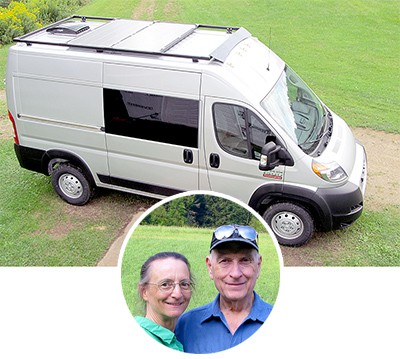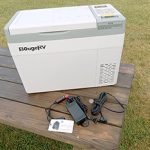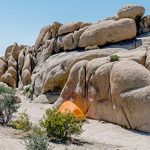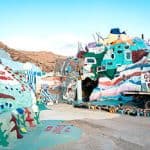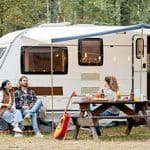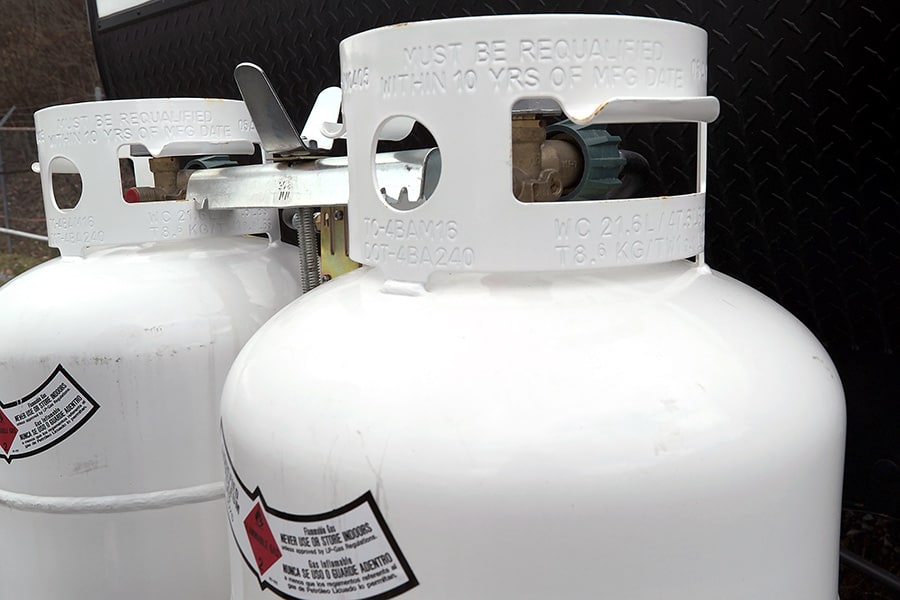
Unless you intend to solely rely on a campfire while camping, bringing along portable gas canisters or tanks for your cooking and heating needs is much easier and convenient than starting a fire. Gas is well suited for cooking in your RV, on camp stoves, powering portable heating devices, or even keeping your fridge cold.
Camping gas vs. LPG: is there a difference? Camping gas is part of the LPG “family” of gases. Liquefied petroleum gas or LPG is loosely used to describe the group of light hydrocarbons: propane, butane, isobutane, or a combination of these gases.
But it may not be as simple as it sounds. When people think of camping gas, they either think of the white 15 or 20-pound propane tanks or the little green Coleman or Bernzomatic tanks. Both of these are easy to transport, store, and provide an excellent way to run camping appliances.
You can use one of or combinations of liquefied petroleum gas for fuel while camping, but there are specific situations in which one may be more suitable than the other. In this post, we will break down some of the differences and their best application for your camping trip and hopefully clear up some of the confusion.
What is Camping Gas?
Let’s start with the white 15 or 20-pound tanks that you commonly see on the front hitch of travel trailers or hooked up to your barbeque grill on the deck. These tanks are frequently referred to as “camping gas” in some areas. But to make it even more confusing, they are also called LPG, BBQ gas, patio gas, bottled gas, propane, LP gas, or many other names depending on the area you live.
Also, different areas and companies will have different proprietary mixtures of gases in their bottles. And the quality of each gas will also depend on where it’s bottled.
A breakdown of the gases commonly found in a 20-pound propane tank will look something like this:
| Percentage | Gas |
|---|---|
| Greater than or equal to 90% | Propane |
| Less than 6% | Ethane |
| Less than 5% | Propylene |
| Less than 2.5% | Isobutane |
| Less than 0.1% | Ethyl Mercaptan |
Since the majority of the gas in these tanks is propane, which is odorless, and the other gases added are either odorless or have a faint smell, ethyl mercaptan is added. Ethyl mercaptan is that rotten egg smell that you encounter when you have a gas leak; it is added as a safety precaution.
For camping purposes or, in fact, any purpose, these tanks or bottles are easy to use and refill. You can have them refilled at the campground where you are staying, hardware stores, Camping World, Pilot Flying J, and other similar locations.
Also, if you don’t want to mess around refilling the propane tanks, you can simply swap them out at various locations. Typically you can exchange the tanks at campgrounds, gas stations, convenience, grocery, and big-box stores. They will usually be in a locked “cage” next to the bagged ice. Exchanging the tanks is easier because you don’t have to wait for someone to track down the person who is responsible for filling them.
When using these “camping gas” tanks on a travel trailer, they typically are the source for heating water, supplying the gas for the cookstove, heating the trailer, or powering the refrigerator. Camping wouldn’t be the same without this easy to use fuel source, nor would be home barbequing.
Now let’s move on to the other “camping gas” we mentioned earlier.
In this section, when we are talking about camping gas, we are referring to the small green tanks of propane that you typically see sold with camping equipment. These small canisters have become popular because they are easily transportable and provide ample fuel for cooking. With a standard-sized 14 to 16 oz tank, you can expect up to two hours of burn time.
Other Posts of Interest
- How To Clean Your Camping Stove And Burners: 16 Tips That Work
- How To Pack A 4×4 For Camping: A Comprehensive Guide
- 9 Tips You Should Know Before Going Camping
- Can Anyone Drive A Camper Van?
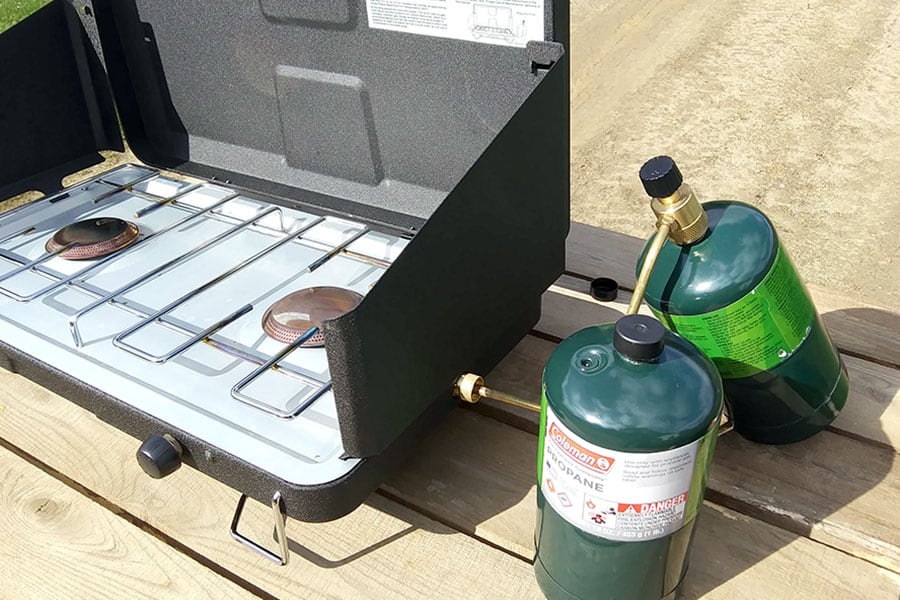
Propane is classified as an LPG, but the distinction between these tanks is that these tanks contain 100% propane versus mixtures of other LPG gases. Propane is an excellent fuel source because it is inexpensive (especially in larger quantities) and is versatile.
You can use propane for your camping stove, grill, and almost any other heating source you may need. Compared to many different fuel sources, propane is also a cleaner fuel that does not contribute to greenhouse gas emissions like gas or oil will.
These are some properties of camping gas (strictly propane) that allow it to burn in your camping applications:
- Compressed liquid: Propane is stored as a liquid in tanks because it can be stored much more densely. This denseness gives you more fuel to burn in a smaller container, making these tanks an excellent choice to run camping stoves.
- Temperature: Camping gas has a boiling point of approximately -44 degrees Fahrenheit, above the boiling point it is released in gas form. This quality makes it easy to use in a variety of outdoor camping environments.
- Colorless and odorless: Propane is a colorless and odorless gas, which typically has chemicals added to make the gas smell. The odorant is a safety feature, so you can be aware if there is a leak.
Most camping tanks hold around 1-pound of propane, which will give you an hour and a half of cook time for most camping stoves. For this reason, it is helpful to keep another tank for backup use.
Propane is an affordable way to run your appliances while camping and also your home. The price will fluctuate depending on the season. Since it is a by-product of crude oil refining and natural gas production, those two commodities will play a significant role in determining what the current price will be.
Using propane as a fuel source will offer you the largest selection of camping stoves to choose from when selecting a stove.
While on the subject of camping gas tanks, some people mistakenly think that it is a good idea to refill the non-refillable (DOT 39) tanks from a 20-pound tank. It is not safe, don’t do it. Propane is extremely flammable, and the tank walls are not made to withstand refilling. Don’t risk your life or the life of a family member or friend attempting to do this.
There are, however, tanks specifically made for refilling. Flame King makes a refillable 1-pound propane tank that is DOT compliant, reusable, safe, and you can refill legally. The tank is compatible with any appliance that you have that uses a 1-pound tank. The kit contains a refill adapter, tank, stand, and cap.
If you want to see how this kit works, watch the video below.
What is Liquefied Petroleum Gas (LPG)?
LPG is typically a by-product of natural gas and oil production. As we mentioned earlier, LPG is the term used to describe the group of hydrocarbon gases, which include propane, butane, isobutane, or a mix thereof. Depending on the fuel source, LPG can vary in proportions of these flammable gases.
In addition to propane tanks, you can purchase other liquefied petroleum gas products that contain either a single gas or a mixture for camping purposes.
When purchasing, you will want to look at the contents of the tank to make sure it has the fuel type you want. The gas in these tanks or canisters can range from mostly propane to containing a majority of butane, and mixtures containing isobutane and other mixes, all serving as good fuel options for camping. Small and portable containers often contain around 20% propane and 80% butane.
Here are some of the properties of butane, so you have a better understanding:
- Temperature: The boiling point for butane is approximately 30 degrees Fahrenheit, meaning that it requires higher temperatures for the fuel to burn. Butane works best when used in warmer temperatures.
- Weight: Containers of butane are a lightweight fuel option, making them easy to transport. If you are camping, this will be easy to carry in a backpack or help to make moving your equipment easier.
- Burn time: You can expect around 2 hours of burn time for a canister of LPG that is concentrated in butane (this will vary by sizing).
Butane is also one of the least expensive gas options, which drives the cost down if it is made primarily of butane. These factors make it a popular choice as a fuel source for camping applications. You will want to make sure that the tank is compatible with the stove you will be using. Be sure to read the literature that came with your specific camping stove.
Finally, the last gas that I want to discuss is isobutane or i-butane. Typically these canisters are isobutane and propane mixes and will have approximately 80% isobutane to 20% propane.
- Temperature: The boiling point for isobutane is approximately 10.94 degrees Fahrenheit. It is extremely flammable, colorless, and is an isomer of butane.
- Weight: Containers of isobutane are available in different sizes, starting at 4 ounces, making them an excellent choice for backpackers.
- Burn time: You can expect about 2 ½ to 3 hours of burn time, but this will vary depending on what size of the tank you have.
Isobutane is commonly used with small backpacking stoves. However, there is a limited amount of larger camp stoves available that will be compatible with this type of fuel canister.
The Differences in LPG Types
Now that we have given you some information about the different liquefied petroleum gases, we will look more closely at the differences between them and when you should consider using one over the other. All are suitable options for a camping stove, but the type of camping you plan to do, the camp stove, and the environment you are in will largely dictate the fuel source you use.
Let’s break down some of the primary differences between liquefied petroleum gas products.
Boiling Point
Doing a side by side comparison, the boiling points of each gas are quite different. Propane boils at -44 degrees Fahrenheit while butane boils at 30 degrees. This feature impacts the ability of the fuel to be used to light your camping appliances. When gas contains some propane and other chemicals, this helps to ignite it if temperatures drop below 30 degrees.
Isobutane is an isomer of butane that is common in gas mixes. Isobutane has a lower boiling point than butane at 10.94 degrees Fahrenheit. If there are higher concentrations of isobutane in the tank of gas, you can take it into colder temperatures than if higher levels of butane are present.
When temperatures are below freezing, it will be more challenging to use butane than propane gas. The temperature factor will allow you to make a decision on fuel type based on the camping environment you will be in.
Flame Temperature
Flame temperature may be an important consideration for you based on the performance and efficiency of the heating source. Flame temperature will impact the amount of time it takes to heat and cook food or to heat a space. The burn time and flame temperatures are similar, but propane has a slightly higher flame temperature.
These are the following flame temperatures of the gases found in each tank used for camping:
| Gas | Flame temperature (in air) |
|---|---|
| Propane | 3,596 degrees Fahrenheit |
| Butane | 3,578 degrees Fahrenheit |
| Isobutane | 3,587 degrees Fahrenheit |
| Propane/butane mix | 3,578 degrees Fahrenheit |
These are not significant differences but may make a difference for extensively longer cooking times. Often you will not be cooking for long enough to notice, but the increase in flame temperature is an interesting difference. Propane/butane will burn at the same temperature as there is very little propane in it to make a change.
Cost
At the time of writing this post you could purchase a:
- 15-pound pre-filled propane tank exchange for $19.97
- 16-ounce tank of propane for $5.56
- 8 ounces of butane for $5.40
- 3.53 ounces of isobutane/propane for $9.99
- 8 ounces of butane/propane mix for $5.74.
The price of different types of gases fluctuates from week to week based on a variety of factors. While purchasing these types of fuels in small quantities will not pose much of a change, it is important to know that the price can change drastically, especially in larger quantities.
These are some of the factors that will influence the cost of natural gases and their by-products (propane, butane, and isobutane):
- Supply and demand
- Availability of other fuel alternatives
- Import and export levels
- Economic growth and stability
Purchasing these tanks of gas in small and portable sizes will be more expensive over time. If you are planning to camp for an extended period, we recommend purchasing a larger tank or a pack of tanks or canisters. If a larger tank is available, it will not only make it easier, so you do not have to refill or dispose of tanks, but you won’t have to spend as much on fuel.
Versatility
Propane is a much more versatile fuel than the other gases, and it is more compatible with different kinds of appliances. In camping, you can use all types of the mentioned liquefied petroleum gases for most camping devices, but propane is the most versatile. It will allow you to use it on more camping stoves, portable heaters, and for almost any use.
For camping and backpacking, you can usually use the small fuel tanks much more easily. Some liquefied petroleum gas canisters come in smaller cans that may not attach to your larger appliances. The more universal the tank is, the easier it will be to use on all different types of camping equipment.
Portability
Each of the choices that we have mentioned is portable and extremely easy to use. Some of the gases even come in multiple size choices to better fit the application that you need it for.
Minimizing the weight of your equipment is crucial if you plan to go backpacking and will need to have all your stuff with you. If this is not a significant concern, then the increased weight of a propane tank is not as significant of a factor.
Availability
You can find these gases at many online retailers, hardware, and camping supply stores, but propane is typically easier to find. Since it is available at many locations, it can make it easier to shop around for the best pricing and also have easy access when you need more. The supply of propane is typically higher as far as natural gases go, making it a resource that is easy to acquire.
Propane has primarily been a more popular option for the many reasons we have highlighted throughout this post. Because of this, it is often stocked much more readily in stores. You should not have issues finding any LPG, but propane is going to be more readily available, especially in the smaller camping sizes.
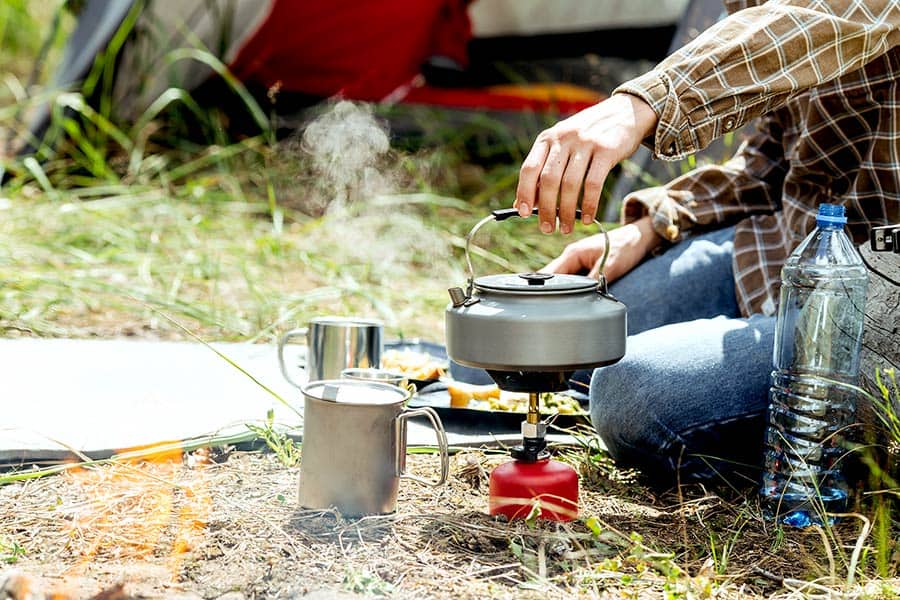
How to Know What Gas To Use
In terms of quality for cooking, all the gases will provide you with the energy and efficiency you need to cook and heat your food efficiently. These differences can help you to decide on what type of fuel you want to use while camping. The next section will detail when you should use one or the other, but in most environments, all are great options for heating.
But based on the differences between the gases, there are some situations in which you should consider using one over the other. Overall, all fuels will work well to operate your cooking and heating equipment while on a camping trip.
These are the primary reasons you will want to use one over the other:
- Type of camping stove and equipment
- Outdoor temperatures and camping environment
- Canister and tank weight
Before you purchase your fuel, you need to look at the camping stoves and equipment that you own or plan to buy. Some of these stoves may only be compatible with one type of fuel. Propane typically comes in small tanks that work well with multiple types of stoves and heating devices, while some of the mixed gas containers can be more variable in sizing and tank nozzles.
If you want to choose a fuel type based on the full range of appliances you can use, propane is a much safer choice. These tanks are very versatile, allowing you to hook them up to your stoves, portable heaters, and other appliances you bring with you camping.
Another consideration when choosing gas is the temperatures and environment you will be camping in. The temperature has to do with the boiling point of the gases, with propane having a much lower boiling point temperature. For camping in cold weather and at high altitudes, propane is the best option.
If you are going to be camping in the dead of winter, you might want to rethink relying on butane as it will not vaporize below 32 degrees Fahrenheit and does not work well at higher elevations.
Isobutane is an excellent option for when you need a lightweight fuel source, but it won’t burn below 14 degrees Fahrenheit.
Mixed gases contain smaller amounts of propane and other chemicals to help combat the cold and altitude. Still, they will be more challenging to burn when you are in temperatures below 30 degrees. For camping in the cold or at high altitudes, we recommend using propane.
Because propane tanks are often heavier than the other gases, if you will be hiking with your equipment, opt for mixed gas tanks.
Using Liquefied Petroleum Gases Safely
Regardless of the kind of gas you use for camping, you will want to do so safely. All gas sources, when kept in their tanks, are safe and should not pose significant risks to you or your family. The easiest way to keep safe is to use them with care. To operate appliances with liquefied petroleum gases safely, make sure you follow these steps:
- Properly attach tanks: You will want to make sure that the nozzle of the appliance and the tank are correctly connected and sealed. The proper connection will make sure that no gas is leaking and that you are taking advantage of all the fuel in the canisters.
- Turn off appliances before removal: Make sure you turn off the stove or appliance before you attempt to remove the gas tank.
- Proper storage: Keep the tanks and cylinders upright, tightly sealed, and away from high temperatures and flames. Safe storage will prevent any explosion or leaking issues. While camping, make sure everything is stored correctly and sealed after use, especially since these will be somewhat close to your sleeping arrangements.
We have detailed the differences between propane, butane, isobutane, and mixes, with all being suitable options for lighting your camping stoves and appliances. With the only significant application differences being in outdoor temperatures and needs for versatility, they are fuel sources that will provide you with consistent and ample energy for heating and cooking.
LPG is very versatile and easy to find. So whether you are camping in the boondocks or grilling on the patio, there is sure to be one LPG product that will work perfectly for whatever use you have in mind.


